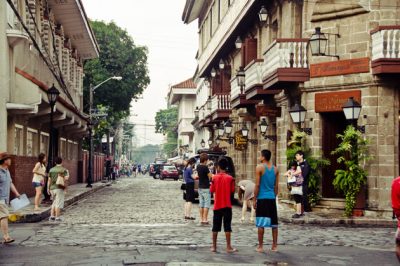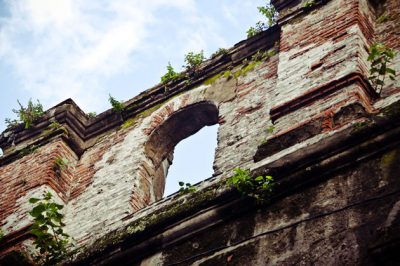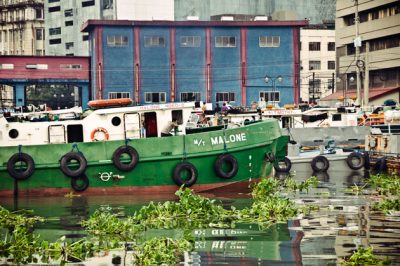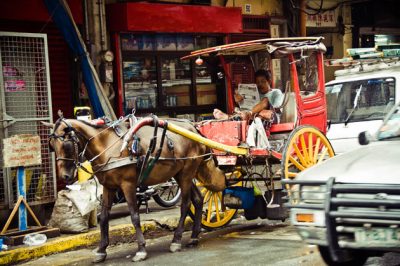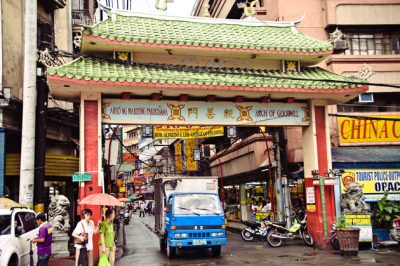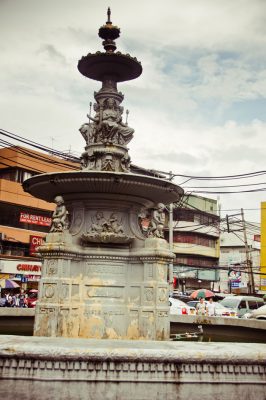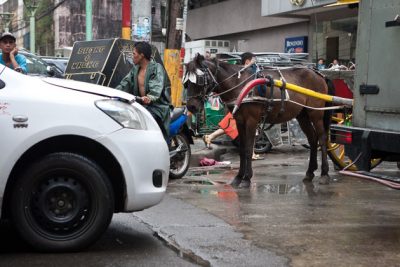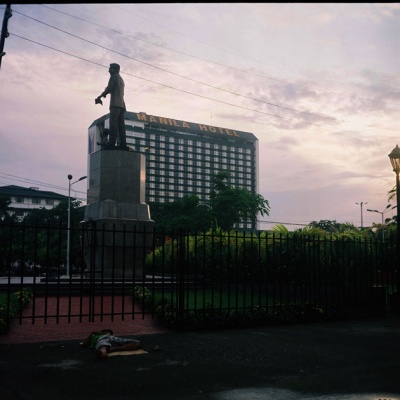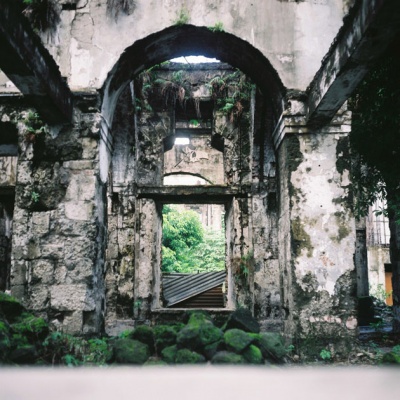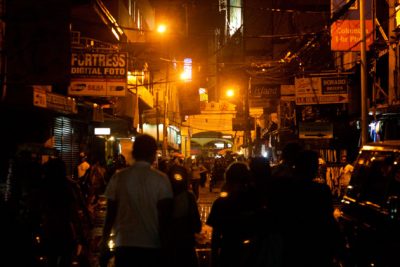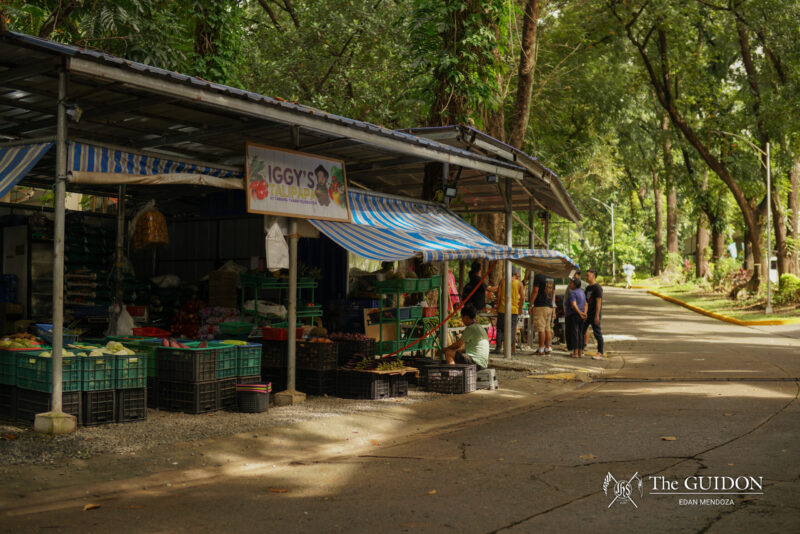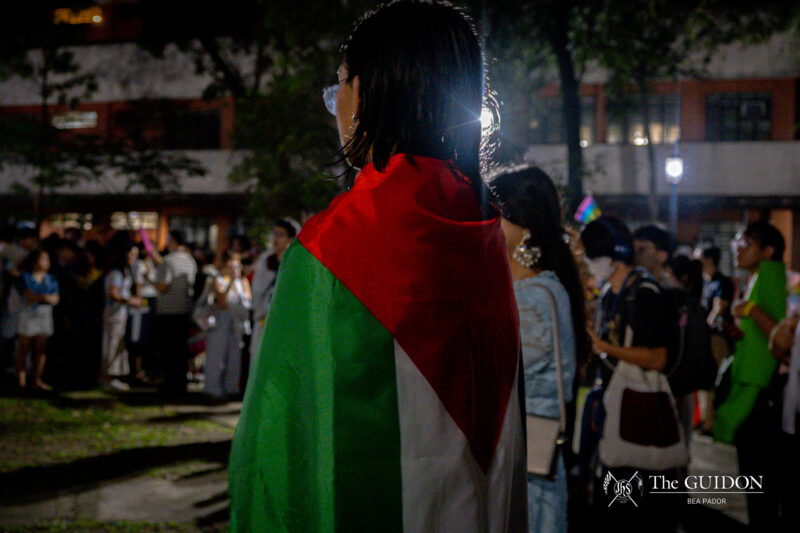Manila is not timeless: the tiny streets of Chinatown that were never meant for cars are now lined with bumper-to-bumper traffic; the houses of ilustrado families in the plazas are now drugstores, supermarkets or schools. Manila is a city completely at the mercy of time.
However, time in Manila does not flow as linearly as it does in other old cities. It sprints down the wide, straight avenues and snakes along the narrow eskinitas, like the great Pasig river that divides the old north and youthful south of Manila.
While not uttered in the same breath as Boracay or Amanpulo, Manila is a tourist destination in its own right.
Becoming tourists
Ateneo alumni Nat Bucag (BS ME ‘11) and Marv Velasco (BFA ID ‘11) are old-timers in Manila. As contributors to the This is Manila photoblog , they take regular trips to the bustling capital to explore the city and take photographs of their adventures.
Over the course of a day, they led us in our attempt to make our way through the density of people and the hazards of the rainy season in our country’s seat of government.
More importantly, we wanted to get lost in it all—to see sights as a tourist would for the first time, while also experiencing it in a way only a Filipino could.
As the train pulled into Recto station, the gray sky over the city signalled the furious downpour outside. We navigated the flooded streets of Quiapo with the rains forcing street vendors to store their wares.
The home of the fabled Black Nazarene loomed over the Plaza, where tall yellow arches that connected to a mosque’s façade formed a square. We made our way to Hidalgo Street, famous for the variety of camera equipment available, and Santa Cruz, where Binondo is located.
Philippine tourism is often centered on beaches—rarely do we advertise cities, which is a shame because our urban spaces tell a unique story of Filipino life.
“Manila is unique because of the dynamism of life in the streets,” Nat shares. “Every day is a struggle but the people are able to cope, much like the old buildings and monuments that have been there for decades.”
A Chinese detour
Before it was renamed in 1915 after a Filipino-Chinese philanthropist, Ongpin Street in Binondo was known as Calle Sacristia, which litterateurs would recognize as a location in Jose Rizal’s Noli Me Tangere.
In Noli, protagonist Crisostomo Ibarra walks its length (though in the fictional San Diego) observing just how little has changed in seven years, noting the same Chinese woman selling fruit on the street and the hazy smoke from the street lamps.
More than a century later, Rizal’s fiction still mirrors life, as Ongpin Street—save for the addition of the obligatory traffic and modern signposts—still retains the charm of the area walked by Ibarra 124 years before. Past the Oriental-style arch, Chinese restaurants abound, as do fresh fruit stalls selling every variety of lychee and cherry imaginable.
Eventually, hunger beckoned us weary travellers, and we traversed the crowded alleys to fill our aching stomachs.
Lan Zhou La Mien, a fluorescent-lit hole-in-the-wall eatery not at all like the extravagantly decorated “Chinese” restaurants in the city, seemed like the perfect candidate.
We ordered a feast of beef, seafood and dumpling la mien, and watched in amazement as the Chinese chef pulled noodles before our eyes as we sipped sweet gulaman and wong lo kat (Chinese iced tea).
When our steaming bowls arrived, we dug into the perfectly cooked noodles swimming in flavorful soup, which was like heaven on the damp, chilly day.
With our hunger satiated and thirst for adventure waiting to be quelled, we set out to conquer the famous walled city that started it all.
Back to our roots
To some extent, the stereotypical notion one has of Intramuros still holds true: the charm of the cobblestoned streets and the Spanish-style buildings make for the perfect time capsule of Old Manila
However, there are now fast food restaurants, as well as a side street covered with graffiti, with the backdrop of Spanish-era structures serving as a blank canvas for street artists.
Yet there are those who stand for keeping the walled city from being dominated by the progress of today. Ilustrado Restaurant, an establishment straight out of the days of Maria Clara, serves both traditional and unique Filipino delicacies, including their legendary sampaguita ice cream.
Though it seemed like nothing more than an unassuming scoop of vanilla or mantecado ice cream, the flavor was a definite surprise: the ice cream tasted the way the flower smelled. It’s hard to describe, but the meeting of the senses made for a delightful treat.
We ended the day by watching the famed Manila Bay sunset. Yet even though we had the best seats in the house, it was difficult to embrace the enchantment of it all.
On the far bank, a neon advertisement competed for our attention, asking if we were interested in renting glass-bottomed boats at the nearby water park; meanwhile, our soundtrack was a bevy of cars and street vendors.
By the time we returned to Hidalgo Street in Quiapo that evening, the once deserted, flooded street had transformed into a night market, complete with racks of clothing lining the streets and vendors calling would-be customers at the top of their lungs.
Walking through Manila makes one sentimental, though one isn’t always sure why. Watching such a historic city change to cope with modern times is bittersweet at best.
Velasco agrees. “While other cities provide you with extravagant monuments, Manila challenges you look through the rubble in order to discover its beauty.”
Finding something new
Manila is a city of irony. The old and new, the rundown and renovated, the exotic and the familiar—it’s easy to dismiss the city as one of the extremes, forgetting the spaces in between.
Those who have seen the city’s beauty, however, always come back. As Marv puts it, “Manila is unique to me because of the beauty I find in its forgotten places.”
Like how most interesting people are, Manila is an acquired taste—an unconventional beauty, if you will—and a trip through her streets is her way of romance. By seeing beyond the initial impression of chaos, you discover her charms and, in a way, fall in love.
- Photo by Sarah N. Aquino
- Photo by Sarah N. Aquino
- Photo by Sarah N. Aquino
- Photo by Sarah N. Aquino
- Photo by Sarah N. Aquino
- Photo by Sarah N. Aquino
- Photo by Sarah N. Aquino
- Photo by Ryan Y. Racca
- Photo by Ryan Y. Racca
- Photo by Joseph S. Angan
- Photo by Joseph S. Angan
- Photo by Joseph S. Angan



